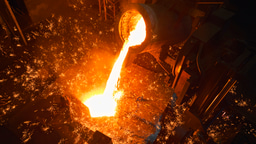When a crystalline solid behaves like a liquid
Published in Chemistry

Since childhood we have learned to discern solids from liquids based on intuition: we know solids have a fixed shape, whereas liquids take the shape of their container. This distinction is both practical and effective for our daily lives. Neverthless the distinction between a liquid and a solid is not always as clear cut, when looking at the natural length and time scales of matter.
Last year, we had just finished building our two-dimensional electronic (2DE) spectrometer, when some fascinating studies emerged suggesting that lead-halide perovskites behave like glass for the lattice but like a crystal for the electrons. An immediate question jumped out: how would glassy structural dynamics impact the electronic response of interest? Ultimately, if the aim is to build a solar cell, it is essential to understand how the electronic system evolves upon absorption of a photon. What we found was that these perovskites, while possessing many properties of a crystalline solid, feature an electronic response typical of disordered liquids on the femtosecond timescale.

Figure 1: How the 2DE instrument looks like. From: Seiler et al., J. Chem. Phys. 149, 074702 (2018)
The key observable in our study was the electronic spectral lineshape dynamics, which is typically challenging to measure. But with two-dimensional spectroscopy, such lineshape dynamics can in principle be accessed cleanly. With our 2DE spectrometer, we were able to obtain the lineshapes over suitable population times to enable new observations and insights. What our work shows is that the ionic character of nanocrystal perovskites yields qualitatively distinct behaviour compared with covalent nanocrystals such as CdSe quantum dots. These ionic lattices that perovskites form have a dynamical disorder akin to liquids and glasses. So what could this insight imply for materials research and in particular solar cell applications?
In the majority of semiconductors we currently use in optoelectronics, the crystals themselves are covalent. We see these covalent semiconductors in bulk form such as Si, quantum well form such as GaAs, and quantum dot form such as CdSe. Our findings yield an immediate distinction in how one thinks of development of these materials. In traditional covalent semiconductors the aim is to minimize and mitigate defects. In ionic semiconductors, perhaps the idea is that defect tolerance by liquid-like structural dynamics can provide new avenues.
Follow the Topic
-
Nature Communications

An open access, multidisciplinary journal dedicated to publishing high-quality research in all areas of the biological, health, physical, chemical and Earth sciences.
Related Collections
With Collections, you can get published faster and increase your visibility.
Women's Health
Publishing Model: Hybrid
Deadline: Ongoing
Advances in neurodegenerative diseases
Publishing Model: Hybrid
Deadline: Dec 24, 2025





Please sign in or register for FREE
If you are a registered user on Research Communities by Springer Nature, please sign in